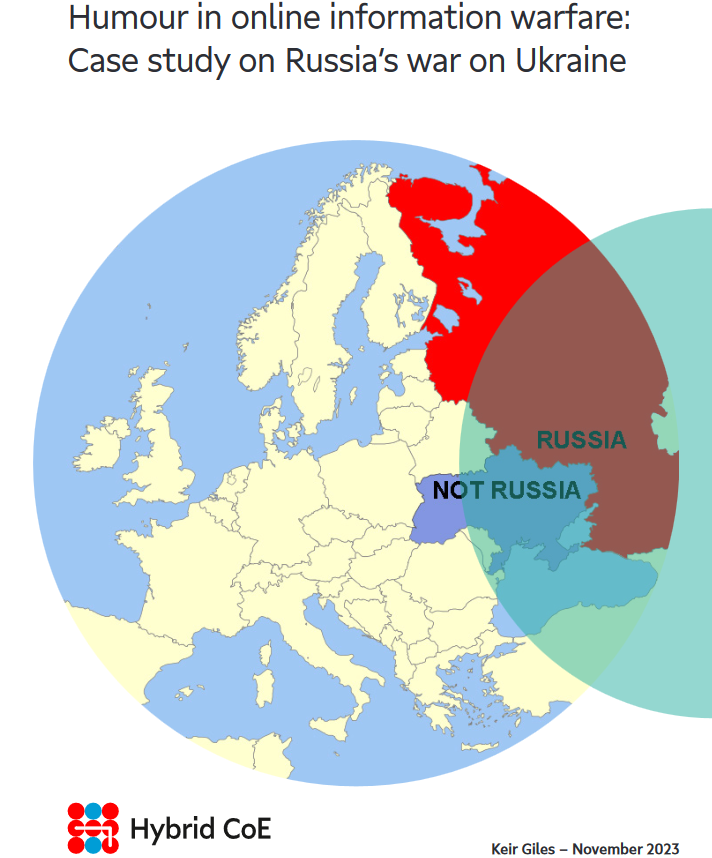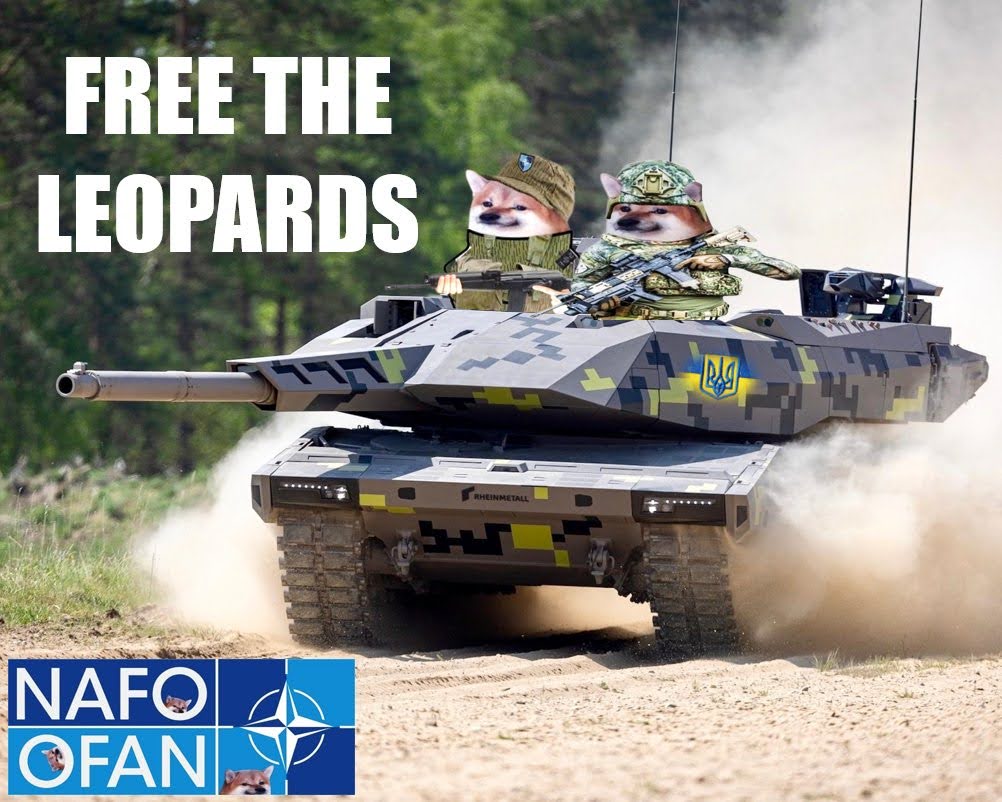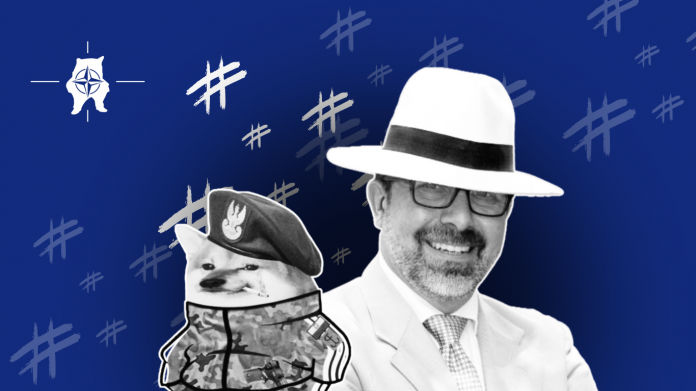In November 2023, NATO’s “Centre of Excellence for Countering Hybrid Threats” published a disturbing ‘working paper,’ “Humour in online information warfare: Case study on Russia’s war on Ukraine.” It received no mainstream attention. Yet, the contents offer unprecedented insight into the military alliance’s insidious weaponization of social media to distort public perceptions and manufacture consent for war. They also raise grave questions about online “trolling” of dissident voices over the past decade and beyond.
The working paper ostensibly “considers instances of humour put to effective use to counter disinformation and propaganda in online spaces, using Russia’s war on Ukraine.” It concludes, “humour-based responses…in the information space and in the physical domain have been found to deliver multiple clear benefits” for Ukraine and NATO.
Avowedly a “practical review seeking to identify examples of best practice from both government and civil society” for wider future application, the paper recommends Western states, militaries, and security and intelligence services master the art of online ridicule under the aegis of “counter-disinformation.”
It contends, “humour…reaches the parts that other countermeasures – like fact-checking or media user education – cannot.” Mass deployment of memes, moreover, “has the advantage of exploiting social media platform algorithms” and addressing “audiences that are not inclined to consume ‘boring’ products.”
As we shall see, the true value in weaponizing “humour” for NATO is distorting the battlefield reality in Ukraine – and future theaters of Western proxy conflict – for public consumption. Meanwhile, any social media user deviating from NATO-endorsed narratives can be subjected to intensive harassment, discrediting them and their message “among a wide sector of online audiences,” if not scaring them away from digital information spaces entirely. The working paper advocates the creation of an army of “private citizens” for the purpose.
‘Incredibly Serious’
The paper begins by noting that “state-backed parody and mockery of the enemy in conflict are nothing new,” citing satirical newspaper Wipers Times, distributed to British soldiers fighting in Western Front trenches during the First World War, and the BBC German Service, which “fought Hitler with humour.” Today though, “social media has democratised access and audience,” therefore “[opening] the playing field to self-motivated private individuals” while “[facilitating] their joining forces in informal collectives for greater effect.”
Multiple footnotes indicate weaponizing mockery is a longstanding NATO objective. A report published by the military alliance in 2017, “StratCom Laughs: in search of an analytical framework,” is cited, while an academic study, “Building a meme war machine: A comparative analysis of memetic insurgencies in cyberspace,” is said to be “forthcoming.” The former caused a mainstream stir upon release. It was, in turn, inspired by a NATO-sponsored paper authored two years earlier by Jeff Giesea, tech guru and Peter Thiel associate, which declared:
Trolling…is the social media equivalent of guerrilla warfare, and memes are its currency of propaganda. Daesh is conducting memetic warfare. The Kremlin is doing it. It’s inexpensive. The capabilities exist. Why aren’t we trying it?”
“StratCom Laughs” was highly influential. In May 2021, the Ukrainian government’s Centre for Strategic Communication and Information Security wholeheartedly endorsed its findings while listing the benefits of “propagandistic humor.”
These included; “[making] perception less critical; [using] common contexts to convey messages with which the audience agrees; [simplifying] everything to the ‘obvious’; [creating] clear groups: strong and intelligent ‘we’ and clumsy and stupid ‘they.’ Of course, the audience associates itself with the former and begins to despise the latter”:
Simplified managed understanding is easily disseminated by the audience and creates the necessary social context for propagandists.”

It’s a highly serendipitous coincidence that the North Atlantic Fella Organization (NAFO) was formed following Russia’s February 2022 invasion of Ukraine. The vast, supposedly grassroots Twitter troll collective, identifiable by “doge” profile photos, inexorably blitzes “vatniks” – Russian officials and anyone failing to toe NATO’s line on the Ukraine proxy war – with a vicious blend of absurdity, ad hominem, memes, and ridicule, while raising money for Kiev’s war effort. The group embodies the pronouncements of “Stratcom Laughs” to a T.
NAFO features prominently in the working paper, with some activists quoted at length. It notes that the collective “grew from a fundraising initiative” for the Georgian Legion, a brutal paramilitary faction active in the proxy war. Unmentioned is that independent financing efforts are necessary because formal Western government backing for the group is politically and legally unfeasible. Its members openly boast of committing hideous war crimes, in particular, executing unarmed, bound Russian prisoners of war in cold blood.
NAFO founder Kamil Dyszewski is a Hitler-admiring antisemite who has heroized white supremacist mass murderers. The NATO paper quotes him saying, “all [Russians] see themselves as incredibly serious and important,” so they “struggle with being made fun of.” This perspective tallies perfectly with the military alliance’s perspective on online psychological warfare. The working paper repeatedly argues, “Russian and pro-Russian individuals and entities are intensely sensitive to mockery and show an inability to cope with being the object of derision.”
‘Courage and Resourcefulness’
The working paper judges NAFO to be an “ideal structure and format” for “countering disinformation, largely through the application of humour and mockery.” The group’s efforts were moreover found to “provide the base material for memes in the form of first-hand images and videos of Russian failures or Ukrainian determination.” This capability augmented “the responsiveness and impact” of Kiev’s “information campaigns,” which were, for example, “instrumental” in securing “US-made F-16 combat aircraft” in August 2023.
These excerpts are striking, for throughout the first 18 months of the proxy conflict, “Russian failures” and “Ukrainian determination” absolutely dominated Western media coverage of the war. The narrative that the invasion was an unmitigated disaster and huge embarrassment for Moscow in every way, and Kiev could pull off a spirited underdog victory and repel the invaders, if not ultimately march upon the Kremlin, as long as sufficient Western Wunderwaffe arrived, was universal and indomitable.
In reality, while there were undoubtedly “Russian failures” and “Ukrainian determination” aplenty from the start, Kiev was economically and militarily crippled within weeks. The “Special Military Operation” was concerned not with conquering every inch of the country but with compelling Volodymyr Zelensky’s government to implement the Minsk Accords and declare neutrality. This was almost achieved in April 2022 via Turkey-brokered peace talks. But then-Prime Minister of the UK Boris Johnson flew to Kiev, offering the Ukrainians the blankest of blank cheques to keep fighting.
The scale of Ukraine’s losses, the dire situation for the country from day one of Russia’s invasion, and British and American intelligence connivances that produced the conflict, concealed from Western audiences by their governments and media, meant siding with and arming Kiev appeared to be the objectively sensible, reasonable, moral position. After all, they were fighting an enemy that embodied absolute evil and incompetence. Helpfully, NAFO was always on hand to relentlessly remind the public of both qualities – particularly the latter.
“Stratcom Laughs” had triumphed. Public perceptions were rendered “less critical.” Serious, complex questions were simplified to “the obvious.” “Clear groups” were created – “strong and intelligent ‘we’ and clumsy and stupid ‘they.’” And Western audiences, “of course,” associated themselves with the former while “despising” the latter. Fast forward to today, and mainstream polls indicate that just one in ten Europeans believe Ukraine can win, with most believing a “compromise settlement” is the only way to end the conflict.
In June 2023, Ukraine launched a “counteroffensive.” Originally intended to start months earlier, it was much delayed due to adverse weather conditions and late weapon deliveries. Officials in Kiev, many Western journalists and pundits, and NAFO all heavily hyped the effort in advance. The group published many memes – some promoted a beach party for “fellas” in Crimea that Summer and others depicted “orcs” fleeing from swarms of leopards.

The latter played on a trope that Ukrainian political and military chiefs and the Western media were extremely keen to perpetuate – that Moscow’s soldiers, terrified of German Leopard 2 tanks, would abandon their positions as the armored vehicles advanced. Instead, they were easily blown to smithereens by extensive minefields created by Russian forces while they waited for the counteroffensive to commence and low-cost lancet drones.
Within just a month, Ukraine had lost 20% of the vehicles and armor supplied by the West, with nothing to show for it. This remained the case when the counteroffensive fizzled out at the end of 2023, with just 0.25% of the territory occupied by Russia in the initial phase of the invasion regained. Meanwhile, casualties may have exceeded 100,000. This can only be considered an absolutely horrendous catastrophe from every angle.
The Washington Post published an extensive post-mortem on the counteroffensive in December of that year. It is clear that among other failures, a fatal error in planning for the effort – overseen by the Pentagon – was the assumption that the Russians would flee in many areas. No alternative scenarios were considered. The Wall Street Journal has also highlighted other egregious strategic shortcomings, which made the counteroffensive’s calamity inevitable:
Western military officials knew Kyiv didn’t have all the training or weapons – from shells to warplanes – that it needed to dislodge Russian forces. But they hoped Ukrainian courage and resourcefulness would carry the day.”
It seems Ukrainians were dispatched on a suicide mission because Western military apparatchiks bought into the simplistic, misleading propaganda narrative of “Russian failures” versus “Ukrainian determination.” Courage and resourcefulness are admirable qualities that Ukrainians have consistently exhibited since February 2022. But they are no match – let alone substitute – for landmines, tanks, fighter jets, artillery shells, and other weapons of war. That confirming this self-evident fact came at the cost of so many lives is a criminal tragedy.
Nobody has all the details but one thing is clear: this counteroffensive will rewrite military history.#Ukraine has stuff in the pipeline the Russians will never see coming. And much of what they do see coming, they won’t be able to stop anyway. #SpringIsComing
— Jessica Berlin (@berlin_bridge) May 6, 2023
‘Punching Upwards’
Throughout the working paper, axiomatic reference is made to how weaponizing humor “imposes costs” on “adversaries” and “aggressors.” Contradictorily, though, it is conceded that “the direct impact on Russia itself is hard to measure.” Indeed, it seems implausible that Kremlin officials and Russian soldiers on the frontline suffer any “costs” whatsoever from the mockery of anonymous Western social media users. This begs the obvious questions of why this approach is considered effective and who the true “adversaries” in NATO’s comedic crosshairs are.
A clue is offered by a passage celebrating how “the overall effect of a community built around humour has been to turn the tables on social media platforms.” As a result, “the agents of influence and other servants of authoritarian regimes, who for so long held the advantage, are turned into the targets rather than the deliverers of mockery and abuse”:
This causes both Russian officials and their extended network of influencers, enablers and trolls to realise that if they choose to serve a criminal regime, they expose themselves to mass ridicule and mockery.”
For “influencers, enablers and trolls,” read: anti-war, anti-NATO, anti-Empire journalists, researchers, activists, and private citizens who dare express the “wrong” opinions or expose inconvenient truths online that challenge NATO-endorsed narratives. This is certainly the case in my regard. The working paper cites me curtly, responding to puerile abuse from a detractor on Twitter as an example of how “those who oppose Russia, China or other hostile regimes publicly face consequences by the hostile regime itself or by its agents and sympathisers.”
Elsewhere, the paper endorses harassment, stalking, doxxing, and creating parody accounts of such “influencers, enablers and trolls” while also warning these are “potential hazards” faced by “individuals taking on authoritarian propaganda structures.” A NAFO activist is quoted as saying, “I’ve seen people get doxxed and harassed, and it doesn’t look fun. I want my family to be safe.” This sentiment is no doubt shared by NAFO’s many targets – but as they “serve a criminal regime,” they’re fair game from NATO’s perspective.
British Ministry of Defence apparatchik Keir Giles authored the working paper. It reveals he “briefly tried to earn a living as a stand-up comedian,” so “knows what it feels like when a joke falls flat.” An apologia he recently authored for Baltic state Nazi collaborators implicated in the Holocaust, in which he claimed they are misunderstood, was certainly not received with much humor. He has promoted the output of a dedicated parody account of none other than myself for some time.

Ironically enough, I would’ve found the account’s posts amusing if they were actually funny. Instead, it has mocked the victims of sexual abuse and also dabbled in antisemitism. In late January, the parody account published a post mocking me for being tormented as a child over my name. Little did I know these lame attempts at ridicule were a dedicated NATO psychological warfare operation.

The latter post gained little traction, and in response, many Twitter users expressed shock and revulsion at such playground bullying behavior. This highlights another shortcoming of NAFO’s approach – the group’s visceral, unabashed, genocidal hatred of Russia and all Russians is so extreme that they frequently repulse audiences to the extent of making them ask if they’re supporting the wrong side by backing Ukraine. Moreover, as Aleksei Navalny ally Leonid Volkov has observed, this output actively assists the Kremlin’s propaganda strategies.
Left-wing alternative comedy legend Stewart Lee has written about the paucity of right-wing standup comedians. He attributes this deficit to right-wing politics being overwhelmingly concerned with punching downward, which is simply unfunny bullying when performative comedy is “a heroic little struggle,” which “should always be punching upwards”:
Who could be on a stage, crowing about their victory and ridiculing those less fortunate than them without any sense of irony, shame or self-knowledge? That’s not a stand-up comedian. That’s just a c***.”
This may well explain why Keir Giles failed in his quest to become a standup comedian and why his “jokes” continue to fall flat to this day. But for all those who oppose war, his working paper is no laughing matter. It is advocacy for the military alliance to create a permanent online harassment battalion to inflict psychological, emotional, personal and professional damage on them while convincing decent people to hate the oppressed and cheer the oppressors.
Keir Giles was repeatedly approached for comment by MintPress News for comment, but did not respond prior to publication.
Feature photo | Keir Giles is pictured with NAFO meme mascot, the NAFO doge | Illustration by MintPress News
Kit Klarenberg is an investigative journalist and MintPress News contributor exploring the role of intelligence services in shaping politics and perceptions. His work has previously appeared in The Cradle, Declassified UK, and Grayzone. Follow him on Twitter @KitKlarenberg.
The post From Memes to Doxxing: Unmasking NATO’s Information Warfare Strategy appeared first on MintPress News.
